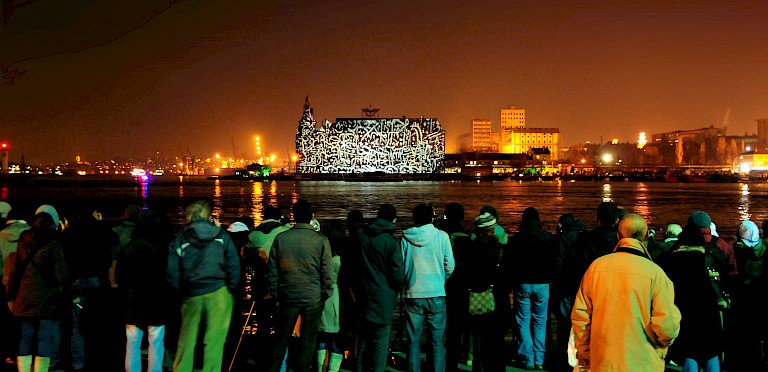



Sited at the iconic Haydarpaşa Train Station, the 2,500 square meter projection evoked the station’s role as a conduit between the Middle East and the West. The station is Turkey’s busiest, and indeed, one of the busiest in Eastern Europe, meaning that Yekpare reached an extremely large and diverse public audience with its captivating imagery, music, and sound. It could also be seen from the Kadıköy Coast, as the projection produced haunting reflections on the surface of the water. The relevance of the projected symbols to different audiences and faiths, combined with the bustle of the projection site and its position in the heart of the city and its history, made for a successful dramatization of Istanbul’s past and present.
As a placemaking initiative, Yekpare’s excellence consists of its sensitivity to the diverse history of Istanbul and its publics, as well as the high quality of its execution. Accurately mapping a projection of the size of Yekpare to the train station constituted a technical feat, and must be considered an important factor in the work’s success, especially as there have been many poorly mapped and low quality urban projections in the recent history of new media. Performed twice in 2010, for three days each time, Yekpare provided to its audiences with poetic encounters with the site, causing some observers to slow down or pause in contemplation and reflection. The project transformed public experiences of the station and its surrounds by interrupting habitual routines of commuting and business, not with commercial advertising, which tends to monopolize technologies of urban projection and spectacle, but with art. This displacement of advertising by media art is commendable, particularly in an era when media and advertising fuelled consumption has become an unfortunate feature and preoccupation of daily life.
The alignment of the project with Istanbul’s status as European Capital of Culture is worth mention, especially given Turkey’s ambitions to become a member nation of the European Union. By highlighting symbols relating to the different religions, Christian and Islamic, as well as older Pagan faiths, interwoven in Turkey’s long history, and by emphasizing the city’s links with both Europe and the East, Yekpare accurately reflects the complexity of the Republic’s contemporary political-economic claims, refusing simple binaries, that Turkey is either European or Middle Eastern, for example, in favor of the idea that it could be both.
All copyright belongs to Shanghai Academy of Fine Arts, Shanghai University.



